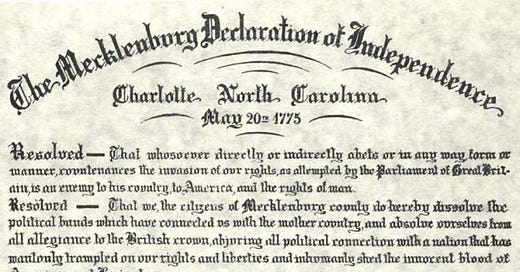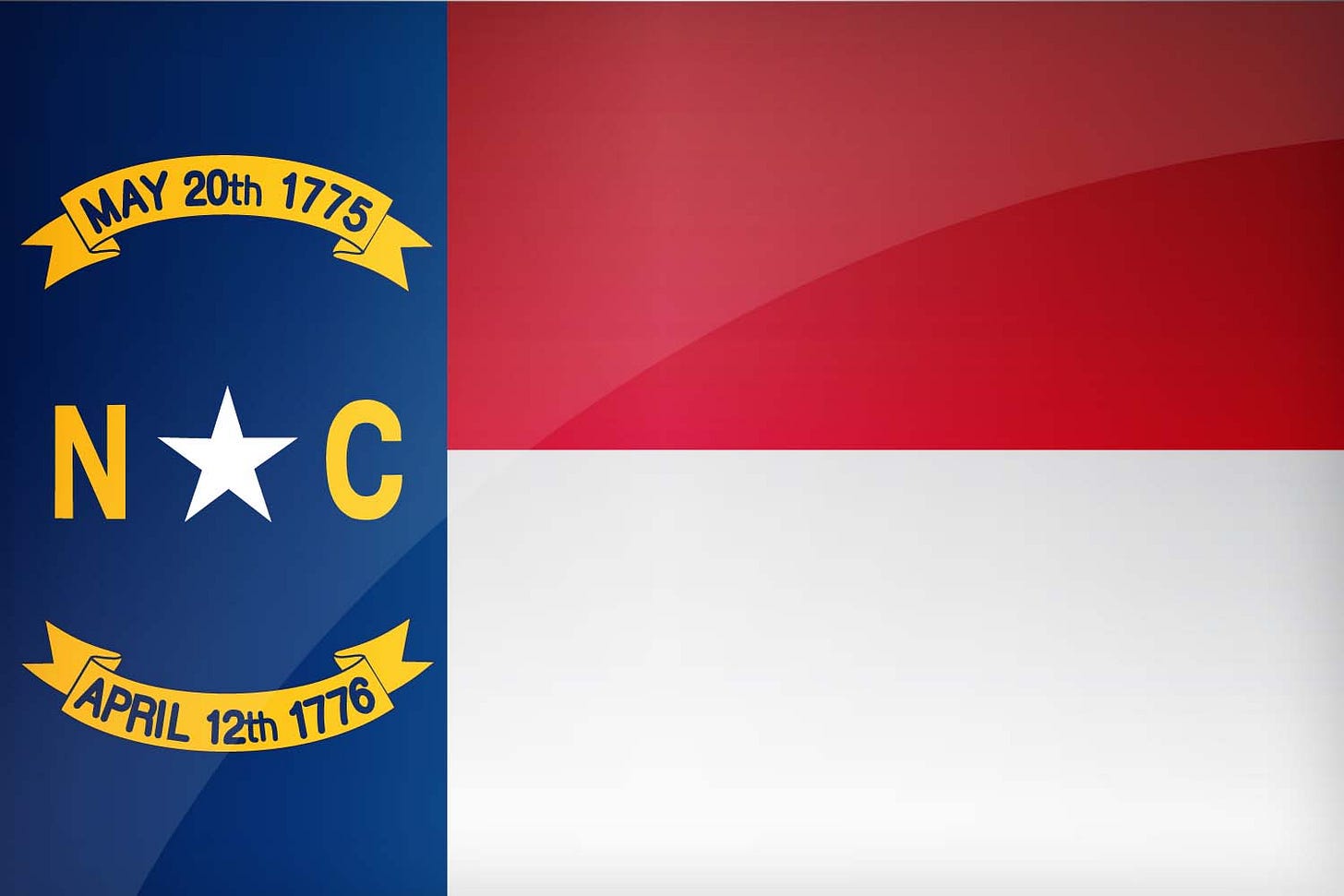Everyone knows that the United Colonies declared their independence from Great Britain on July 4th, 1776, … though technically the vote was taken on July 2nd … but not everyone is aware that some colonies had already declared their independence. Delaware, for example, had declared their independence from Great Britain AND Pennsylvania on June 15th. In fact, by the time Congress declared independence for the United States, 10 of the 13 colonies had already independently declared independence. This had led to many claims for bragging rights as to who declared independence first.
Enter the citizens of Mecklenburg County in North Carolina. On May 20th, 1775, … more than a year before the Congressional declaration … they had met in Charlotte after hearing about Lexington/Concord and passed the Mecklenburg Declaration of Independence, which unambiguously stated:
“Resolved, That we the citizens of Mecklenburg county, do hereby dissolve the political bands which have connected us to the Mother Country, and hereby absolve ourselves from all allegiance to the British Crown, and abjure all political connection, contract, or association, with that nation, who have wantonly trampled on our rights and liberties — and inhumanly shed the innocent blood of American patriots at Lexington.”
And North Carolina uses this declaration as proof that its citizens were first in line on the independence train. There’s only one little fly in the ointment. … the Mecklenburg Declaration may have been faked, as no copy of the alleged declaration existed. Those making the claim of the declaration’s authenticity point to a fire that destroyed Mecklenburg’s records, while doubters claimed that without hard evidence, the veracity of the story is impossible to prove.
The studious reader of 5-minute History may be wondering how it is possible to quote from a document … as was done above … that was lost in a fire or never existed. The answer to that oddity is that, in 1819 a copy suddenly appeared, though it’s unclear where it came from. If authentic, it would validate the story … but many had reason to question its veracity. This is due in part to the similarity in language between the alleged Mecklenburg Declaration and the Declaration of Independence. For example, the following wording appears in BOTH declarations.
Dissolve the political bands which have connected
Absolve ourselves from all allegiance to the British crown
Are, and of right ought to be
Pledge to each other, our mutual cooperation, our lives, our fortunes, and our most sacred honor
If these words were written in 1775, then Jefferson plagiarized a document that wasn’t found until 1819 or, alternately, the document found in 1819 was a hoax that plagiarized Jefferson.
The controversy was so important to North Carolina that in 1829 a select committee was appointed to settle the matter. Without any other resource to go on, they spent a few years tracking down survivors who were present at the time. Some were decorated veterans of the revolution, others were respected community members, such as ordained ministers. Their eyewitness testimonies may have been backed by nothing but their word, but their word was considered above reproach. In 1831, the committee issued a 32-page report arguing that there was validity to the story. This, however, settled nothing. Doubters of the story pointed out the those interviewed were recalling events over 50 years old, while supporters claimed the eyewitness testimony was gospel.
Then, in 1838, a historian threw a new bucket of fuel onto this fire when he discovered a series of “resolves” made in Mecklenburg and dated May 31st, 1775. That the people of Mecklenburg passed these resolves is without question, as copies of the resolves were traceable to their date. These resolves were passed 11 days after the alleged declaration, but they fall far short of a declaration of independence … but easily within the failing memory of aging patriots … leading many to conclude that the Mecklenburg Declaration is just an embellished recounting of the Mecklenburg Resolves.
Nevertheless, North Carolina chose to honor two dates in its history on the official State flag. The second date honored is April 12th, 1776. That was the date that the North Carolina provincial Congress issued the Halifax Resolves, in which their delegates to the Continental Congress were authorized to support independence for the confederacy. But the first date, located in the most prominent honor spot of a flag, is May 20th, 1775, … the date of the Mecklenburg Declaration, which may or may not have actually happened.
So, will history ever resolve the Mecklenburg Declaration controversy? Likely not. History can be murky at times … but then its murkiness becomes history. Is there any harm in believing that the Mecklenburg Declaration is authentic? No, it’s plausible. Independence was “in the air” in 1775, and independence was probably on many lips about which we’ll never know. Does it even matter if the Mecklenburg Declaration is the Mechlenburg Resolves misremembered by aging patriots? Not really, at least not outside of North Carolina, where they claim the bragging rights associated with the Mecklenburg Declaration right on their flag.
But, even if the Mecklenburg Declaration never happened, North Carolinians can still claim an undisputable bragging right in the Halifax Resolves, as they were the first colony to authorize their delegates to the Second Continental Congress to support independence as a confederacy from Great Britain. This means that North Carolina was the first to call for American sovereignty, and an independent United States.
And, after all, the Unanimous Declaration of the Thirteen United States of America is the one history counts.
NEXT WEEK: SCOTUS and Sick Chickens





